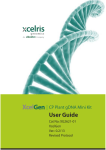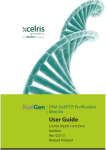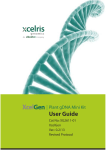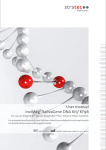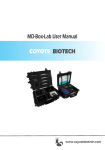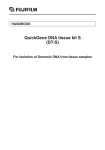Download Manual - Xcelris Genomics
Transcript
Bacterial gDNA Mini Kit User Guide Cat No: XG2411-01 Bacterial gDNA mini kit Table of Contents Introduction 01 Storage and Stability 02 Kit Contents 02 Before Starting 03 Bacterial gDNA Spin Protocol 04 Bacterial gDNA Vacuum/Spin Protocol 06 Trouble Shooting Guide 07 Related Products 09 Limited Use and Warranty 09 Bacterial gDNA mini kit Introduction XcelGen Bacterial gDNA kit provides a rapid and reliable method for purification of high quality genomic DNA from a wide varieties of bacterial species. Bacterial cells are grown to log-phase, harvested and process to DNA purification. The bacterial cell wall is initially digested with appropriate enzyme to loosen cell wall. Following initial lysis, bacteria is lysed with chaotropic salt solution to promote complete lysis and DNA release from the cells. Our proprietary DNA binding system that allows the high efficient binding of DNA to our binding matrix while proteins and other contaminates are removed under certain optimal conditions. The DNA bound to the DNA mini silica column and purified DNA is easily eluted with sterile water or elution buffer. Purified DNA is suitable for PCR, restriction digestion hybridization techniques and other applications. Highlights Spin column technology Quick and simple procedure for complete recovery of gDNA 109 bacterial cells can be processes per column Common protocol for gram-positive and gram-negative bacteria Organic solvent (Phenol, Chloroform) free system Recovery of 15-30 g of bacterial gDNA, depend on the type of strains 01 Bacterial gDNA mini kit Storage and Stability Shelf life for provided kit is 12 months from the date of purchase. Once reconstituted in water, Proteinase K and lysozyme must be stored at -20oC. Store RNase A at 4oC. Other components can be stored at 22oC-25oC. BL/TL buffers may forms precipitate upon storage. If necessary redissolve by warming to 37oC, and then store at room temperature Kit Contents (Kit is supplied at prescribe temperature) Product XG2411-01 Storage Preps 50 RT DNA Mini Columns 50 RT 2 ml Collection Tubes 100 RT Buffer TL 15 ml RT Buffer BL 15 ml RT Buffer KB 28 ml RT DNA Wash Buffer 15 ml RT Glass Beads 1.5 g RT Elution Buffer 15 ml -20OC Lysozyme 50 mg -20OC Proteinase K 30 mg -20OC RNase A (20 mg/ml) 270 l -20OC User Manual 1 1 Buffer BL contains chaotropic salts, which may form reactive compounds when combines with bleach. Do not add bleach or acidic solutions directly to the preparation waste. 02 Bacterial gDNA mini kit Before Starting Read the entire procedure prior to starting the experiment. Work area, equipments and hand should be completely free from dust Carry out all experimental procedure/centrifugation at room temperature o Use pre-warm water/elution buffer at 65 C for efficient elution of gDNA DNA Wash Buffer: Add 60 ml absolute (96%-100%) ethanol and store at RT Preparation of stocks: ProteinaseK Preparations Prepare a stock solution of Proteinase K (provided) as follows and aliquots into sterile eppondroff tube and store. Bring Proteinase K solution to room temperature before use. XG2411-01 Dissolve with 1.3 ml of Elution Buffer Lysozyme Preparations Prepare a lysozyme stock solution at 50 mg/ml and aliquot into adequate portions. Store each aliquot at -20oC and thaw before use. XG2411-01 Dissolve with 1 ml of Elution Buffer Materials to be provided by User Table top microcentrifuge Water bath set to 30oC Shaking water bath set to 55oC Dry bath or water bath set to 65oC Absolute ethanol (96%-100%) Nuclease-free 1.5 ml tubes, tips, pipette 03 Bacterial gDNA mini kit Bacterial gDNA Purification Spin Protocol This method is designed for isolation of gDNA from 1-3 ml log phase grown Bacteria culture. 1 Pellet 1-3 ml culture by centrifugation at 12,000 x g for 2 min at room temperature. 2 Discard medium completely and resuspend the pellet in 180 l TE Buffer or Elution Buffer. Add 18 l of 50 mg / ml lysozyme solution and 5 l RNase A, incubate at 30oC for 15-30 min. Note: Complete digestion of the cell wall is essential for efficient lysis. Longer incubation time may yield more genomic DNA. 3 Centrifuge the cells at 5,000 x g for 5 min at room temperature. Discard supernatant and leave10 l residual liquid in the tube. Resuspend the cell pellet by vortexing. 4 Add 25 mg glass beads and 200 l Buffer TL. Vortex at maxi speed for 5 min. Allow the beads to settle down to the bottom of the tube and transfer supernatant to a new 1.5 ml centrifuge tube. 5 Add 25 l Proteinase K and vortex for 10 seconds. Spin down briefly. 6 Incubate the mixture at 55oC in a shaking water bath for 30 min. If no shaking waterbath is available, briefly vortex the samples every 2-3 min. (Optional: Centrifuge at 10,000 x g for 2 min to pellet insoluble debris. Transfer the clear supernatant to a sterile microcentrifuge tube.) 7 Add 220 l Buffer BL and briefly vortex to mix. Incubate at 65oC for 10 min. A wispy precipitate may form upon addition of Buffer BL (The precipitate does not interfere with DNA recovery). 8 Add 220 l absolute ethanol and mix thoroughly by vortexing for 20 sec. If any precipitation can be seen at this point, break the precipitation by pipetting up and down 10 times. 9 Transfer the entire sample from Step 8 into a DNA mini column, including any precipitate that may have formed. Centrifuge at 10,000 x g for 1 min to bind DNA. Discard the collection tube and flow-through. 10 Transfer the column into a new 2 ml tube and add 500 l Buffer KB. Centrifuge at 10,000 x g for 1 min. Discard flow-through and reuse the collection tube. Note: Saturation of column with Buffer KB enhance the binding of DNA to column 04 Bacterial gDNA mini kit 11 Place the column into the same collection tube and wash by adding 650 l DNA Wash Buffer diluted with ethanol. Centrifuge at 10,000 x g for 1 min. Repeat again step 11" to remove contaminatents. Note: Make sure that appropriate volume of ethanol is added in Wash buffer solution (refer to before start) 12 Discard flow-through and put the column, with the lid open, into a new collection tube and centrifuge at maxi speed (10,000 x g) for 2 min to dry the column.. Note: Residue ethanol will be removed more efficiently with the column lid open. 13 Place the column into a nuclease-free 1.5 ml microfuge tube and add 50 l of pre- warmed (65oC) elution Buffer to DNA Mini column. Allow columns to incubate at 65oC for 2 min. Note: Incubating the DNA column at 65oC for 2 min prior to centrifugation will give a modest increase in DNA yield. 14 Centrifuge at 10,000 x g for 1 min to elute the DNA. 15 Repeat the elution with a second 50-100 l Elution Buffer. Note: Each 50 l elution typically yields 60-70% of the DNA bound to the column. Thus two elutions generally give~90%. However, increasing elution volume reduces the concentration of the final product. Volumes lower than 50 l greatly reduce yields. In some instances yields may be increased by incubating the column at 70oC upon addition of Elution Buffer. 05 Bacterial gDNA mini kit Bacterial gDNA Vacuum/Spin Protocol Note: Please read through previous section of this manual before using this protocol. 1 Prepare samples and column by following step 1 to 9 on page 5. 2 Prepare the vacuum manifold according to manufacturer s instructions and connect the column to the manifold. 3 Transfer the sample/BL/Ethanol mixture to the column. Turn on vacuum to draw the sample through the column. 4 Add 500 l Buffer KB and allows the buffer to pass through the column by vacuum. 5 Wash the column by adding 650 l DNA Wash Buffer and draw the wash buffer through the column by turning on the vacuum source. Repeat this step with another 650 l DNA wash buffer. 6 Proceed step 12-15 on page 6. 06 Bacterial gDNA mini kit Trouble Shooting Guide Problem Possible Cause Possible Cause Column Clogged Too much bacterial culture Do not use greater than 3 ml culture at OD600 1.0 or 1 x 109 bacterial cells per spin column. For larger volumes, divide sample into multiple tubes Incomplete Lysis Add the correct volume of Buffer TL and incubate at 55oC to obtain complete lysis. It may be necessary to extend incubation time to 30 min. Celll not lyse properly Add more lysozyme or increase the incubation time. It may be necessary to increase incubation to 30 min. Clogged column See above Poor elution Repeat elution or increase elution volume (see note on page 6). Incubation of column at 65oC for 5 min after addition of Elution Buffer may increase yields. Improper washing DNA Wash Buffer must be diluted with absolute (96%-100%) ethanol Low DNA Yield 07 Bacterial gDNA mini kit A260 / A280 ratio No DNA eluted 08 Extended centrifugation during elution step Resin from the column may be present in eluate. Avoid centrifugation at speeds higher than specified. The material can be removed from the eluate by centrifugation - it will not interfere with PCR or restriction digests. incomplete mixing with Buffer BL Repeat the procedure, this time making sure to vortex the sample with Buffer BL immediately and completely. Insufficient incubation. Increase incubation time with Buffer TL. Ensure that no visible cell clumps remain. Trace protein contamination Following step 11, wash column with 300 l Buffer KB before proceeding to step 12. Poor cell lysis due to improper mixing with Buffer TL Mix thoroughly with Buffer BL and incubate at 70oC prior to adding ethanol. Incomplete cell wall blasting Add more lysozyme or extend the incubation time. It may be necessary to increase incubation by 15 min Absolute ethanol not added to lysate/Buffer BL mixture Before applying sample to column, an aliquot of ethanol must be added. See protocol above. No ethanol added to Wash Buffer Dilute Wash Buffer with the indicated volume of absolute ethanol before use. Bacterial gDNA mini kit Related Products: 1) 2) 3) 4) 5) 6) 7) 8) DNA Gel/PCR Purification Miniprep kit (XG3511- 01/XG3514) Agarose, Hipure(LE) (XGA-100) 100 bp DNA Ladder (XGM250) 1 kb DNA Ladder (XGM1k) Premix Taq V2.0 (XG334A) Taq DNA Polymerase (XG00007-1000/ XG00007-10000) Pfu DNA Polymerase (XG00021- 100/ XG00021- 500) dNTP Mixture, 10 mM each (XG0056) Limited Use and Warranty This product is intended for in vitro research use only. Not for use in human. This product is warranted to perform as described in its labeling and in XcelGen s literature when used in accordance with instructions. No other warranties of any kind, express or implied, including, without limitation, implied warranties of merchantability or fitness for a particular purpose, are provided by XcelGen. XcelGen s sole obligation and purchaser s exclusive remedy for breach of this warranty shall be, at the option of XcelGen, to replace the products, XcelGen shall have no liability for any direct, indirect, consequential, or incidental damage arising out of the use, the results of use, or the inability to use it product. For technology support or learn more product information, please visit our website www.xcelrisgenomics.com 09












